Common Thailand Snakes
[Last Updated: 19 July 2023]
Snakes in Thailand You May See
When visiting Thailand on vacation or for a long-term stay there are certain snakes you are likely to see and others that you will probably never see, even if you’re looking very hard to find them. On this page is a selection of common (frequently found) snakes in Thailand. If you want a FREE EBOOK of COMMON THAILAND SNAKES in PDF format – CLICK HERE.
If you need the ultimate headlamp for herping – this Petzl Bluetooth programmable headlamp is one of our best:
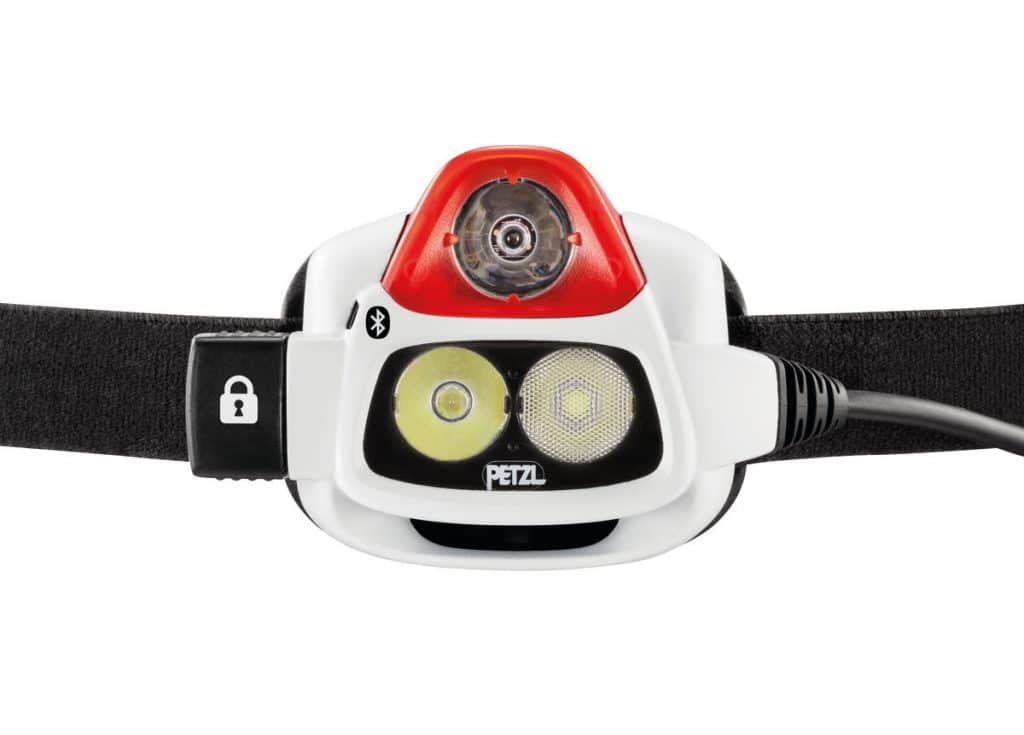
Non-Venomous and Mildly Venomous and Harmless Snakes found in Thailand
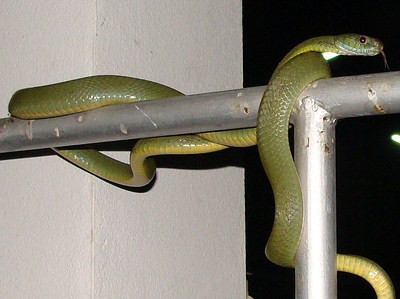
Green Cat Snake (Boiga cyanea)
This green snake is almost 2 meters long when fully grown, and resembles the vipers – except it’s too long to be a viper. Be very careful with any green snake as there are many vipers with strong venom that are green and look very similar to this one.
Green vipers typically have brown-colored tails. This snake has a solid green tail. The Green Cat Snake shown in the photo is harmless and didn’t even try to bite as I interacted with it on my porch in Southern Thailand around midnight.
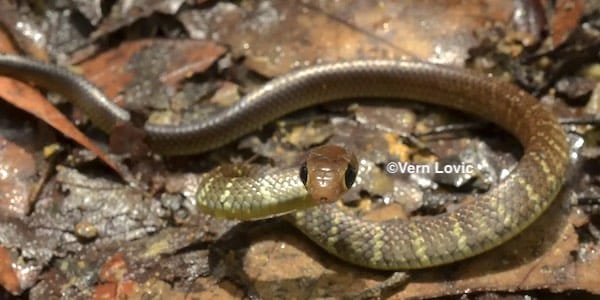
Indo-Chinese Rat Snake (Ptyas korros)
One rat snake, the Indo-Chinese Rat Snake, is especially common, but the adult does look very much like the monocled cobras to the untrained eye. Do be very cautious of any snake that is solid brown, grey, black, or that is mostly dark with some white spots – speckles or odd patterns. Cobras are quick to bite and one of the most deadly daylight snakes you’ll encounter. There is a photo of the monocled cobra below.
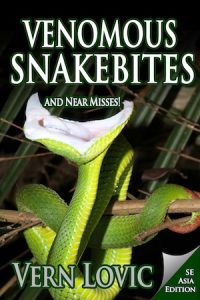
Venomous Snakebites and Near Misses
More than 34 stories of venomous snakebites and very near misses from Southeast Asia’s most deadly snakes – King Cobra, Malayan Pit Viper, Monocled Cobra, Banded Krait, Malayan Krait, and more! Digital Book with over 100 pages of interesting reading.
Order HERE – (eBook)
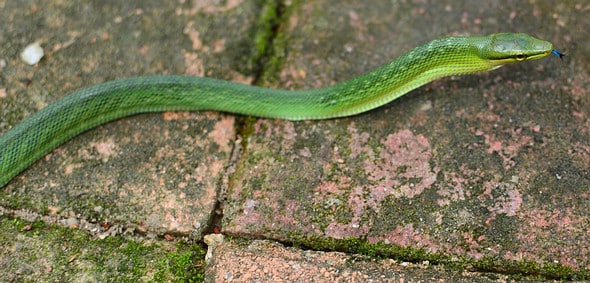
Red-tailed Racer (Gonyosoma oxycephalum)
This is a fairly large rat snake reaching around 2.1 meters in length. It has no fangs to deliver venom and can be considered harmless to humans. It does bite, of course, so stay out of reach. This is an incredibly beautiful snake with green hues, blue-green eyes, and a black and blue tongue. Stunning!
If you haven’t yet read this book about Dr. Joe Slowinski – a biologist bitten by a many-banded krait in Burma in 2001 – you really should. It’s an excellent read, and ALL SNAKE HOBBYISTS SHOULD READ IT.
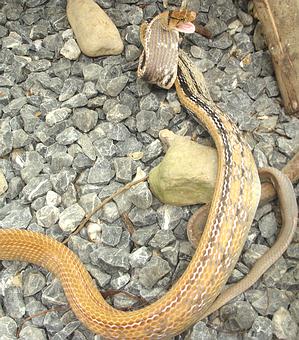
Radiated Rat Snake (Coelognathus radiata)
Also called the Copper-headed Racer – These are very common and may even qualify as one of the most commonly seen snakes in Thailand. Non-venomous and not dangerous, except they are big biters. Many small teeth.
A bite can hurt and get infected because the teeth easily break off inside the skin. Color hue ranges from yellow to brown, There is another rat snake in Thailand that looks very similar – the “Malayan Racer” which is very dark brown with a slightly different pattern (Coelognathus flavolineatus).
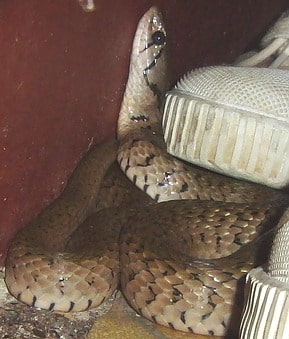
Keelback Snakes (Oligodon / Rhabdophis / Xenochrophis genera)
Keelbacks are very common ground snakes and love water. You might see them in the water or on the ground moving around. Keelbacks are generally easily identified by distinct black (dark) lines from the eye area toward the jaw. Most keelbacks in Thailand are not very dangerous, but there are a couple in the “Rhabdophis” genus that are to be considered dangerous and potentially capable of a deadly bite. We have one featured in the venomous section below (Rhabdophis subminiatus).
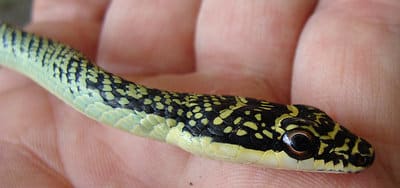
Golden Tree Snake (Chrysopelea ornata)
A very common green tree snake across Thailand and their favorite food appears to be Tokay Geckos (Gekko gecko), so you may see one at your home. These snakes have a mild venom that doesn’t generally affect humans at all.
These snakes do traverse across the ground but quickly find a tree when threatened. Masterful and very fast climbers! Common in homes, garages, and other structures.
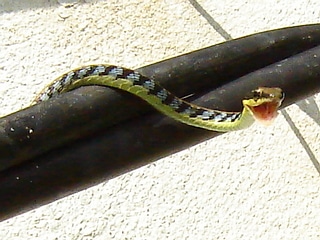
Bronzeback Snakes (Dendrelaphis genus)
also incredibly adept and fast climbers, I first saw one as it came over my six-foot concrete wall in the back of the house in Surat Thani. Very thin snakes, not that afraid of humans. This snake bites quickly – as you might guess from the photo.
To be honest, I’m holding the tail so I can get a good photo before it quickly disappears. Mildly venomous colubrids, and not dangerous to humans. There are many species of this snake, all look vaguely similar.

Oriental Whip Snakes (Ahaetulla prasina and Ahaetulla mycterizans)
Very common snakes, and usually found in trees during the day (active) or night (sleeping), but I have found many whip snakes on the ground as they hunted lizards and frogs. The bright fluorescent green in this snake is awesome, isn’t it?
These snakes have mild venom, but again, no serious results of envenomation have occurred in humans. Other color variations: yellow, very light green with much more white (A. mycterizans), grey, brown. There is also a speckle-headed whip snake which isn’t found very often.
Common Venomous and Deadly Snakes in Thailand
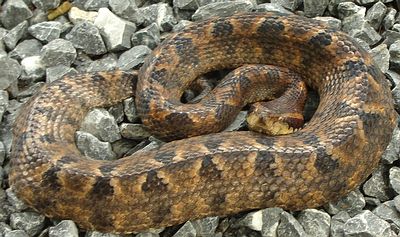
Malayan Pit Viper (Calloselasma rhodostoma)
A very dangerous pit viper with strong cytotoxic venom which is potentially deadly. This common brown pit viper is the cause of death for more people in Thailand than any other snake. It bites quickly and is lazy to get out of the way if you’re walking toward it, usually, it just lays still.
Always found at ground level, and often on top of, or just under leaves. Maximum length – about 1 meter long.
Monocled Cobras (Naja kaouthia)
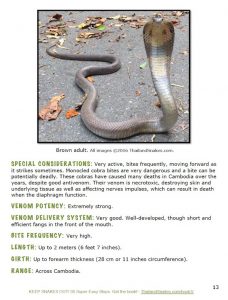
Be especially careful of cobra snakes which can spit venom 2-3 meters away (farther with a strong wind!). They can temporarily blind you as they make their getaway, but the problem is your eyes will be burning until you can flush them with water for 10-20 minutes, and then visit the hospital to ensure they are properly cleaned. Photo above (click to enlarge) is of the Monocled Cobra (Naja kaouthia)
Red-necked Keelback (Rhabdophis subminiatus)
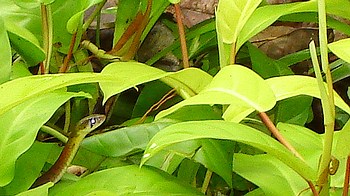
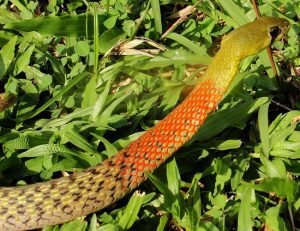
Brightly colored and very common snakes that become more brightly patterned when agitated. These brightly colored snakes are found in captivity across the globe. They were previously considered non-venomous and not dangerous until recently. Death has occurred as a direct result of envenomation from this species, though not in Thailand.
In Thailand, we have had a number of close calls. Renal failure after bites is one of the possible potentially deadly outcomes. This is one of the few snakes which is venomous and poisonous.
There is a poison secreted in the dorsal (top) side of the neck area near the head which can be dangerous to pets or people licking them. You know, in case you ever got the urge. In some cases, the Red-necked Keelback can spray the poison from the neck in a very fine mist.
Malayan Krait (Bungarus candidus)
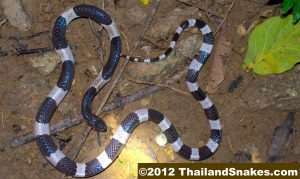
Malayan Krait. Kraits are all venomous and potentially deadly. They are active by night for the most part, though I have seen Red-Headed Kraits (Bungarus flaviceps) active during daylight twice.
The Banded Krait and the Malayan or “Blue” krait are both deadly snakes – the former with yellow and black bands about the same thickness, and the latter with black and white bands, the black bands are thicker near the neck, and more evenly spaced farther down on the tail.
Small-spotted Coral (Calliophis maculiceps)
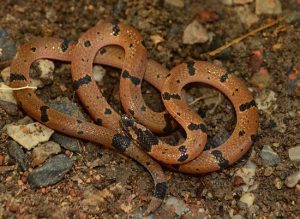
Small-spotted Coral. There is one frequently seen coral snake in Thailand worth mentioning, not because it’s all that common, but because it tends to be around the gardens – even in potted plants. This is the “Small-spotted Coral Snake.” It is very small – around 35 cm as an adult, and it looks harmless enough. It should be considered dangerous – and capable of potentially deadly bites.

Venomous Snakebites and Near Misses
More than 34 stories of venomous snakebite and very near misses from Southeast Asia’s most deadly snakes – King Cobra, Malayan Pit Viper, Monocled Cobra, Banded Krait, Malayan Krait, and more! Digital Book with over 100 pages by Vern Lovic.
Order at Amazon HERE
Common Snakes in Thailand 1 >
Non-Venomous Snakes in Thailand
- Common Non-Venomous Snakes Post #1 Post #2
- Brahminy Blind Snake
- Brown Kukri Snake
- Copper-Headed Racer / Radiated Rat Snake | IndoChinese Rat Snake | Oriental Rat Snake / Banded | Red-Tailed Racer | Ridley’s Racer | White-Bellied Rat Snake
- Dragon Snake
- Laotian Wolf Snake
- Malayan Bridle Snake
- Orange-Bellied Snake
- Red-Tailed Pipe Snake
- Reticulated Python | Blood Python | Burmese Python
- Striped Bronzeback
- Sunbeam Snake

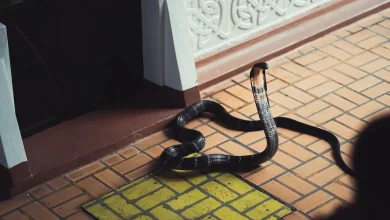
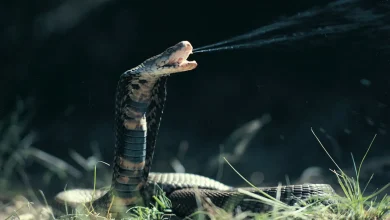
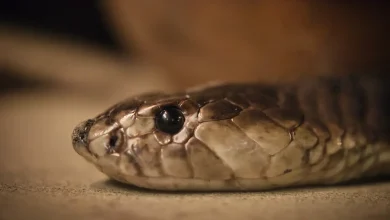

I absolutely love your site. I am a novice herpetologist enthusiast at best and while I would love to know what snakes I run across, the ones in Thailand seem incredibly dangerous and unpredictable.
Any chance you are a lizard enthusiast as well?
Hi Ron – thanks for your comment. I like lizards a lot – but, I can’t possibly manage to learn about everything and keep it straight in my head. I have a lot of lizard videos and snake videos at my YouTube site here: Thailand Videos
I like your site, very interesting.
We have some snakes living in and around our garden. When I say some, I mean one very, very big python, which I made a short video of and it looks like it has a dog or something similar inside it, making its slow way into the undergrowth outside.
We have found a clutch of about 40, hand sized eggs that the neighbor sent to the local vet.
We have in the last few weeks seen a fairly big, 1 metre, green diamond backed snake that our dog saw off. That was in our garden, it’s now under some wood in the garden and me, my wife, the maid and the kids are a bit scared to go near it as it was fast.
We had a constrictor outside our kitchen, behind a rubbish bin that was eating a frog and looked a bit like the 1 metre snake with the diamond back, but was much smaller. The one eating the frog was only about 1 foot long.
Not long ago a python was climbing our tree outside, it was about 4, 5 feet and not very thick, about twice a thumb thickness.
I fight with my wife all the time as she tries to kill them and I have to stop her, although I must say, I am getting a bit tired of how frequently they appear.
Keep up the good site, it must take a lot of your time keeping it updated, but worth it.
The large python
http://youtu.be/LuSJJlxVltc
The frog eating snake
http://youtu.be/6FVzNJjTgm0
http://www.youtube.com/watch?v=6FVzNJjTgm0
Thanks for your comment Peter – where are you located at? Sounds like quite a snakey place. Cheers, Vern
We get frequent visits to our Edge of Junglr Garden by various reptiles – mainky snakes, lizards etc. Currently we have observed Red Back Snakes of various sizes. The Maid wants to kill them but I believe they are hunting the frogs/toads we have in our back garden. Trouble is when we do see a snake we do not have time to run into the house to find our Snake ID Book to see if dangerous or not. Only worried if my kids are confronted by one. Otherwise live and let live. Like your site. Well Done. Tony R.
Hi Tony,
I sent you email with links to 5 photos of snakes with red backs. Let me know which you think it is… Cheers…
Hi Vern..I live in Pai, Maehongson. Our house is pretty rural..so see snakes fairly regular..saw one this morning I’ve not seen before..looked like a rat snake but with a golden head. Really beautiful..bout a meter long. Have looked on Google but can’t find one similar. Nice site btw. Cheers
Hi Toby,
What was the color of the rest of the body?
Hi Vern,
I like your site very interesting and well explained!
Many Specimens that I had never seen before visiting your site.
Continue to send us your videos who are very informative.
Takes care of yourself and be careful…;-)
Cheers
Andy
I just had a 3 meter Python in the Garden, i stay in the Coconut land on Koh Samui, i love snake, thanks for your site…..i can finally put names to some of the creatures i see.
hi, thank you for the site living in phuket my thai wife,child and now i have been seeing what we now believe(thanks to your site) to be a golden tree snake in our yard . same behavior you describe very fast an ground then goes up a tree in our yard we have planted many papaya trees and he can hide in them easily.
what are the chances oh a Malayan Pit Viper finding its way into our yard and hiding under dead papaya leaves? we live in a quieter part of phuket near many rubber plantations.
we all have a live and let live attitude like many thais , just would like to keep the deadly snakes away if possible.
cheers , tom and family
Hi Tom,
I think Malayan Pit Vipers can be found just about anywhere on ground. I’ve found them under leaves too. Recently there was one in my driveway in a subdivision – surrounded by a brick wall. How it got in – no idea. It’s always good to be cautious if you have kids around.
Cheers!
Hi,
I live in Phuket and had my first snake encounter this morning. It was long and thin just over a metre and was gliding across my roof. It was a pale green colour with a nice pattern along the body and at the head. I took a photo and went for help but when I returned it had gone.
Thanks for an extremely informative site.
Regards,
Mike
Hi,
Im currently on vacation in Thailand (right now in Hua Hin) and, although I have no knowledge about snakes, I have always been fascinated by them and, above all, by their beauty.
One of the Thai guys who I have been do some horseriding tours here seems very concerned by my interest in snakes – the Thais seem fearful and very superstitious of this creature. Den informed me that if you kill a King Cobra, you better make sure that you kill his wife, too (or vice versa) as he/she will come after you. He honestly bleive this …. I didn’t even know that snakes lived in couples !
Anyway, love your site and has certainly kindled my interest in snakes even more !
Kind regards
K
Hi Kay, Thanks for your comment. Hua Hin has a lot of snakes – outside of Bangkok, this is where I get the most requests to identify snakes people see in Thailand.
Ha! Thais have some great superstitious beliefs… the killing of the king and the husband or wife coming to get you is one of the best. Snakes don’t live in couples. No sense telling them otherwise though.
Have a great vacation,
Cheers,
Vern
Hi. Im curently on obsurvation in bandon hoapital in koh samui as a snake bot me….after 5 hours…still no symptoms…just the place where i got bitten on the anckel. Safly i didnt see what bit me, but it was on mainai beach on the north pf koh samui. 5 minutes before that we saw a green snakemclimb a palm tree on the beach and the. I got bitten by the snake i diidnt see 5 minutes later about 5 or 10 meters aeay on the grund.
What do you thinkmit might be and how dangerus..doctors wouldt say and recomended 24hour hospital stay…
I have all ready killed 3 cobra snakes in the last last 2 months here in the Phichit area, one of them was a baby so I know there will be about 30 or so more in the area. Dogs have found them each time.
Hi.
New to the site. Can you help with identifying a snake. It could be a tree snake but the colourings are not the same as the above picture.
Hooped green and black body on top (maybe plain pale green underneath).
It was quite small (maybe one foot long if stretched out), very thin (like a pencil in the middle and needle thin at the end). Wrapped itself around a table leg naturally.
Any idea’s?
I live in an estate in Phathum Thani – so a “townie” really. Came across a large, about four feet long, brown snake, curled up under some garden sacking on the patio. As I approached it ‘wriggled’ out and blew itself up to around twice the thickness! Then hid itself behind some loose brickwork. I got the gardener to remove it. He told me it was harmless, – a rat snake?
Good question… maybe. How thick? Any pattern at all? When it doubled in size, was a pattern revealed?
Vern, I just found your site and appreciate the useful information very much. We are building a house with a decent sized garden and pond in the Pranburi / Sam Roi Yod area south of Hua Hin. Recently we came across in our car a dark gray or black snake crossing the country road from one pineapple field to another. Grassy area, lightly wooded, but nearby hills are heavily wooded. I caught just a quick glimpse of it and was worried I had run over it despite swerving to miss it. The snake looked to be about 2 meters long and perhaps 5-6 cm across at the midsection. I think I saw slightly lighter gray patterning on the back, but can’t be sure. When I stopped, turned around and returned to look for it it was not on the roadway. Either I missed it or it was a very tough snake.
Hi David,
If you ran it over – it will likely die. They can still sometimes move for a bit, but internal bleeding probably gets most of them after being run over by a vehicle. Sounds like a rat snake – you have Ptyas mucosa and Ptyas korros up there, both of which could possibly fit the description. For the most part, your king cobras are yellowish. Cheers!
Great website, Thanks!
I spotted a snake today, crossing the narrow road between a lumyai orchard and the Ping River, not too far from Lamphun…. The snake was maybe around a metre long, fairly stocky, and the colour was a deep coppery hue, appeared to be all over the snake
I was out on the bike, so slowed for a look and kept going … I’ve run into all sorts of cobras, kraits and such out on my rides, plus I used to live in Australia ( say no more!) so, I’m used giving any snake a wide berth..
Any ideas as to what it might have been? Cheers!
Cobra?
Hi Vern. I saw a 200 mm by 8 mm black snack with yellow stripes over its head about 6 weeks ago about three quarters of an hour north of Pattaya and wonder about its identity.
Hi Roger,
I’d guess you saw a Golden Tree Snake. Did you see it during the day or night? In a tree? On the ground?
Here’s a link to our common snakes page, and the golden tree snake (C. ornata) is shown with some photos. Chrysopelea ornata >
Is that it?
Cheers, Vern
It was during the day and I would say that you are right, a golden tree snake, and being so young didn’t look quite the same, the pattern not so developed. Can I say the pattern was more like a zebra than a leopard.
Oops. You said 200mm. Not 2,000 like I was thinking.
It could have been that snake. It couldn’t have been a king cobra, there’s no way they’re hatching up there, they haven’t even mated yet. Are you sure the bands were over the head? I wonder if it could have been a banded krait? I don’t think the bands ever go over the head though. Tough call.
Hello,
Could you tell me what is this snake ? I found it in my house http://___
Thank you.
send it by email. Click Snake ID link at top right of website.
Just met a guy who was bit on Pattaya Beach at night walking on the side walk next to the beach, Beach Road. There are many rats on the beach, so the snakes are probably in the palm tress. He didnt see the snake. It was a poisonous bite and his leg has blown up 3 times since antivenom at the hospital. What snake might it have been.
Malayan Pit Viper most likely. It wouldn’t be up in a tree though. Was he leaning against a tree when the bite happened?
Great site for snake ID
I saw a 1.5 metre black snake. It seemed to have slightly paler rings towards the tail. Very fast mover. Also “ran” away from me faster than I did to it. Leapt 2 metres into space departing the back veranda. Typical venomous snake with smallish head compared to the main body. Tapered to a long thin tail.
If I was in Australia, I would have called it dugite shaped and sized but blacker in colour.
I am mildly worried because it seems to have moved in to my back garden.
Many frogs, insects and geckoes in tall grass I am raising for my ducks.
It seemed far different to rat snakes. Any ideas?
If the head was not huge – like a king cobra head, then there is a better probability it was a rat snake. There are a few of them, but I think you probably saw the Keeled Rat Snake. Ptyas carinata, they are pretty common and get big. Sounds like what you described.
Hi there
Just come across your website as I am from New Zealand where we have no snakes whatsoever. We are traveling to Thailand (first time in my life) for 8 x nights and I am absolutely terrified of coming up against snakes. Can I hire a snake bodyguard while I am in Thailand ? Please can I call you or something to discuss basic precautions for staying here?
Hi Daniel, It’s very hard to even FIND a snake. You have very little to worry about. If someone stays in Thailand for an entire YEAR, even if they do the typical tourist things – like kayaking in the mangroves, or hiking on trails, I’ll bet that most people would not even SEE a snake during that year. They are not that common. Relax!
my dogs just had some fun with this snake in the garden. Couldn’t really match it to anything in your website. Can you advise?
Oi! I found a dead snake about a meter long and thin. Small head and brown/black and yellow “herringbone” markings. Hard to describe but beautiful. Juvenile rat snake? Wish I knew but no camera. Paul L Venne in Inthrapat area west of Bangkok on Phetkasem Road. (Many klong around here and turtles too.)
Vern, On reflecting on my dead snake find, I have never seen rats in my area. A many many frogs croaking after the rains, yes. Centipedes and millipedes and geckos and turtles and big roaches and a 3″ spider, yes, but not rats. Also it was long and thin with a maximum body size about the size of a woman’s little finger. 1.2cm? So what would my snake find be? I don’t remember it’s small head having big eyes either. I will look tomorrow to see if it’s still there and get a picture which leads me to a new question. If it is a new species to science how do you report it? Thanks, Paul/Inthrapat
Another problem for me is how to store a dead snake for ID? Not in my small fridge I think! Thanks again, Paul
Hi. Thank you for this great site!
I am from Canada and moving my family to Thailand for 1.5 yrs for hubby’s work. We have a 2 yr and a 2 month old boy. I’m wondering what your thoughts are on living in a more rural area (40 mins out of Bangkok towards Pattaya) vs high rise in Bangkok. The rural area would be right beside a golf course undergoing full renovation, so acres of clearing land. It has an outdoor kitchen and 2 pools.
Is this rural living safe for curious kids to explore. Do you think my 2 year old would be safe outside by himself when it comes to snakes?
I am not too scared of snakes but of course, I fear for my children’s well being in general and the thought of venomous snakes possibly biting them keeps me awake at night, now.
Are my worries founded, in your opinion?
We have the choice also to stay in nice high rise apartment with a rooftop pool in Bangkok. I don’t like cities but this might be safer for my boys safety.
I made this post to help families considering moving to Thailand – Moving to Thailand and Snakes
Hi Vern
I do a lot of wild freshwater fishing around Pattaya and also in Trat where I often come across snakes. I always wear leather sneakers and jeans but would like to know if they can bite through thick enough denim? Do you wear any sort of special clothing when herping?
I don’t Steven. The Malayan Pit viper and the Siam viper could bite through most anything. As could a king cobra and probably a monocled. The fangs on some snakes are ULTRA sharp. Sharper than a needle. I showed that in my comparison of a juvenile king cobra’s fangs and a needle. We took some shots with a macro lens and the difference was incredible. The fangs are MUCH sharper. If you are not very knowledgable about what’s in your area – and how to avoid them – I’d wear the rubber boots the agricultural workers wear in TH. A king might possibly bite through them with a perfect grip, but not likely. You’re not likely to be bitten by a king in the forest anyway. Cheers… Photos here – https://thailandsnakes.com/sharp-king-cobra-fangs/
Hi Vern
I just posted on Thaivisa than found yr site.
Hi was just taking the dog for a wander round the garden (south of CM) and he suddenly jumped back. Very skinny snake was a metre or more long. Instead of just killing it I perhaps stupidly thought “must get a picture so can check if it’s dangerous” Had to go and tie the dog up first came back with iPad and couldn’t find it. I have a pretty good memory of what it looked like. What would a clever man do to identify it. I know there’s a snake guy Vern and site…..is that a good place for identification? Wife’s mum lives just 10-15m from where I saw him or her. The snake was the length I said, very slim white belly and under head, long slim blackish stripes down the sides contracted with a much lighter colour, vaguely greyish top. He held his head up looking at us kinda prepared for danger. Head somewhat wider than body.and THE head may have had a little colour. He was beautiful in perfect condition. I want to know if he’s dangerous. Please advise we don’t want to lose Mum
Thanks!
kia ora
just found a 4ft snake in the house. Black and white chevron body, with orange head..
‘ Noo sar ‘ they said it was called ..bugger if I know if it was dangerous, but I nice looking snake..
Hi Vern,
On 3 Jun 2018 at approximately 2 PM, I was driving from Samoeng to Mai Rim (Chiang Mai area). As I made my turn toward Mai Rim, I spotted a 2 Meter Cobra near the white road line. I was able to swerve to avoid hitting it (barely), but it lifted the front of it’s body approximately 1/2 meter and opened up it’s hood. Thank god I was paying attention or it could have ended substantially worse. I attempted to turn around and get a picture but by the time I turned the motorbike around it had disappeared into the brush. My girlfriend, who is Thai, was thrilled at the sighting although I was just glad I wasn’t hugging the line as I usually do on that stretch of roadway.
Very nice website! I stumbled upon it while trying to identify a snake found on the beach at Ko Lanta. It appears to be a yellow-lipped sea krait. Facinating snake, it stayed on the beach until nightfall and the slithered away with the coming tide. Thanks for having the site :)
Sure thing – glad it helped!
Do snakes have a home territory?
About a month back there was a large snake on the spare land next to our building in Phuket.
It was around for 3 days in the same place at the same times, afternoons.
It wasn’t scared of people, didn’t move away. The Thai workers at the building all went to see the snake and take photos on their phones, they called it a cobra.
It hasn’t been seen since, will it have moved away or is this its home area and its still here?
Hi there,
Yes, a lot of snakes have a home territory – possibly all. They find a place they are comfortable and stay there as long as it’s safe, comfortable as far as temperature and humidity, and provides food. Cobras are known to stay around one spot – yes.
Saw some beautiful snakes over my years in Thailand, including a Banded Krait in Lopburi, 20 minutes after my girlfriend telling me there were no snakes near the family home! Gotta love the Thais and their white lies. I felt privileged to see one though, didn’t even know what it was until I got home and googled it. Unmistakably a Krait.
Wish it was me! I’ve seen a big one DOR, but not alive yet.
I would prefer “kill them all” :D I saw one green snake (80cm long) climbing on 7th floor if condominium in Bangkok. I had to help it fly dosn :D Unfortunately snake landed without harting itself and ran away (BTW I gave it over 10 minutes to run away but I cannot risk Nd wait more). Now I am thinking what should I do to avoid unexpecte guest on my balcony.
Hi Vern,
Could you kindly help me to identify a snake my wife saw today?
We live in Chiang Mai. Not outside of the city (near to Promenade Mall)
Today, approx. 10:00 am , my wife (also American~she has very little knowledge about the snakes here, but learning~) saw a snake in our yard, she ran into the house and called me.
It went under a bush. I never did get to see it as I think it went thru to neighbor’s yard and away.
I tool a rake, and also a water hose to see if it was still in the bushes so that I could glimpse it.
She described it to me and we looked thru some pictures but are still not for certain.
Her description:
Yellow underbelly, she was absolutely certain of this
Back was green she said, but not a bright green, then she described a more brownish green, , almost like olive green.
thanks,
King cobra? Oriental whip snake? What was the thickness? the length?
Hello Vern
Posted here before about 4 years ago about a dead banded krait on the road outside my place near Chiang Rai. Since then have seen 2 more on my nocturnal rides on the bike out in the country.
Today out in the back yard by the pond the wife is yelling snake snake! The son comes and gets me and out I go and find a live banded krait, again about 1.5M long, along with 2 other dead snakes caught in the fish netting the neighbour strung up over the barbed wire to keep our ducks out of his rice field. About 2 weeks ago the wife called me out back and there was a dead rotten snake in the same netting which I removed.
So after getting a knife I cut and cut to get it free and then it still had a chunk around its neck I had to get off. A beautiful snake with its alternate bands of black and yellow. Once totally free it kept hiding its head under its belly while extending its tail out and twitching it at us. Had a bad abrasion on its belly but I think and hope it will survive. with us there it would not leave. We walked away and after about 10 minutes it slithered away. GOOD!
For sure I got a chore tomorrow removing all that netting so it does not kill more snakes.
James
Hi James,
Yeah, that fish netting can trap all sorts of things. Snakes get caught in it easily. Lucky you to see a live 1.5m banded krait. Amazing snakes, yes. I wonder if it was lured in by the dead snakes. They’re snake eaters, though they also eat rodents.
Send a pic next time, if possible.
Cheers,
Vern
Hi Vern,
Few year ago I was playing golf in Hua hin / Majestic course (pretty much in a jungle at the time). We were the first group and I was walking ahead of others. When I walked under a palm tree a black snake, about meter long and thick as normal male arm from wrist high dropped from the tree just next to me.
It went away in a second so I couldn’t spot any details. I am pretty sure there wasn’t any particular patterns or other colour in it.
Great if you can give any answers what could it been. Sorry for the lack of info. Cheers, Mikko
OK, here are some possibilities:
King Cobra (O. hannah)
Indo-Chinese Rat Snake (P. korros)
Banded Rat Snake (P. mucosus)
Keeled Rat Snake (P. carinatus)
Monocled Cobra (N. kaouthia)
It could have been a very melanistic (dark) snake of another species.
Cheers.
Hi Vern,
As I was driving back down the mountain towards Phang Nga from Khao Sok national park (about 10 mins from the park entrance, so still very much high in the jungle), I saw what I thought was a large broken tree branch on the opposite side of the road. One end of it was raised diagonally, about 2-3 ft off the ground, and was probably between 2.5 – 3m in length, around the width of a male forearm I guess.
As I approached, I realised it was a snake, and it quickly turned to make its way back into the undergrowth. It moved quickly, lowering its head slightly, but still keeping it off the ground, with quite a pronounced ‘S’ movement. It was reddish brown in colour, with what could have been a slight diamond pattern on its back. It looked like the diamond pattern was made by an outline of the diamond shape, but wasn’t filled in with any major differences in colour, if that makes sense.
As I was driving, this all happened fairly quickly, so was unable to get a shot of it. Any ideas what snake that could have been?
Cheers!
Paul
Hi Paul,
At that length, there aren’t too many snakes that fit the description. King cobra, Burmese Python, Reticulated python, and one of the rat snakes. You said it moved fast – which pythons don’t really do, at any size. “Fast” can be subjective, so maybe you considered it fast and it was a python. Pythons have a pattern while rat snakes and king cobras don’t – with exception of some simple light colored bands (or light and dark for P. mucosa). I think probably not a rat snake.
The way you describe it moving – with head raised as if moved forward… pythons don’t tend to do. King cobras and rat snakes do.
Impossible to say which one it was!
Cheers man
Thanks for the quick reply! You’re right, when I say ‘fast’ it wasn’t rapid, but yep, quicker than pythons tend to move at, from what I’ve seen. It was quite elegant in the way it moved off, rather than jittery. I’ve only ever come face to face with a king cobra once in the wild, in Kathu on Phuket, and that was a much lighter grey colour. Do kings in the south come in darker brown / reddish colours too?
Sure! King cobras can be darker brown, yes. Yellowish. Black. Dark olive green. I haven’t seen any resembling reddish.
Hi Vern.
We saw a yellow whip snake in Chiang mai province today, very long and thin. I didn’t think whip snakes were yellow. I guess I’m wrong. Peter and Val.
Hi there,
Yes, yellow, grey, green, and light brown, and some very whitish.
Cheers!
Thanks Vern, very nice snake, not at all aggressive and very gracious. And I’d like to say, congratulations for your website, I’ve referred to it 2 or 3 times before in the last few years. You seem like a pretty smart guy, a Nirut farang perhaps! Pete and Val.
Hi,
I check your site regularly to try and identify snakes. I see quite a few in my garden, most of them kukris I think.
I have some video of them eating frogs on my porch.
My wife saw this one close to our daughter and killed it. More than likely not a dangerous one, but if u could identify it, I could try and teach her not to be so quick to break another broom over a snake.
Fotos:
https://ibb.co/1QZBXx3
https://ibb.co/znr3WST
It’s a keelback in the Xenochrophis genus. Harmless for people and pets (cats/dogs).
Thank you
bright green and black stripes, small, foot long?
Golden Tree Snake, Paradise Tree Snake, Green Keelback, Green Rat Snake (Ptyas nigromarginata). Those are all I can think of at the moment.
Hi this morning I found a small snake , if u could kindly help me identify please , Also how do I add the pic ?
You can send through the ABOUT|Contoct us link (https://thailandsnakes.com/contact/).
Hi, I (actually the dogs) just came across a snake in the garden, which I managed to remove by use of a broom. No longer than a metre in length and dull brown towards grey with some low-contrasting markings, it curled the end of its tail, which was white and obviously intended to distract an attacker from its head end. I didn’t get a photo unfortunately. I’d have said a cobra based solely on your pictures above, except it didn’t flare its neck, though it did lunge at the broom. Can you identify it from this poor description?
Sounds like a Malayan Pit Viper I guess. It’s hard to figure out. They have white tail tips when juvenile, but that’s nothing near 1 meter long. Can’t think of another snake with white tail tip. Cobras flare hoods at least a little bit with almost every strike, so not sure.